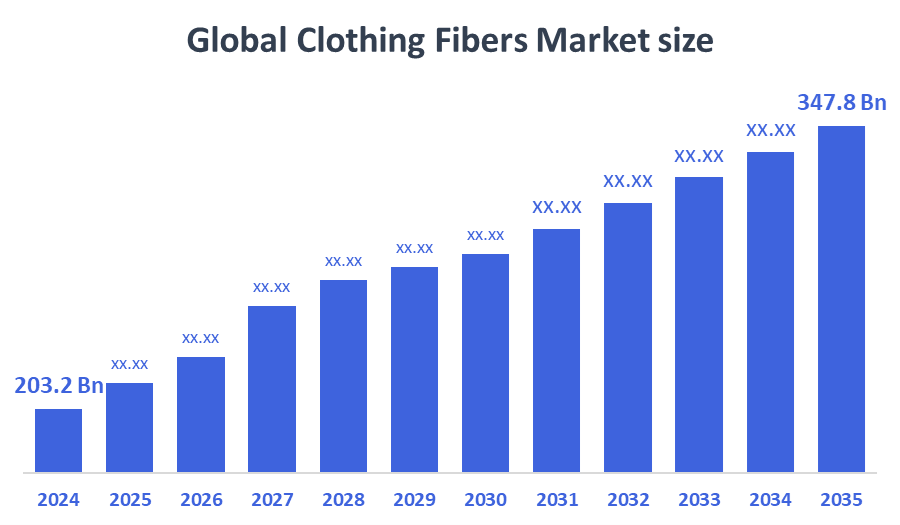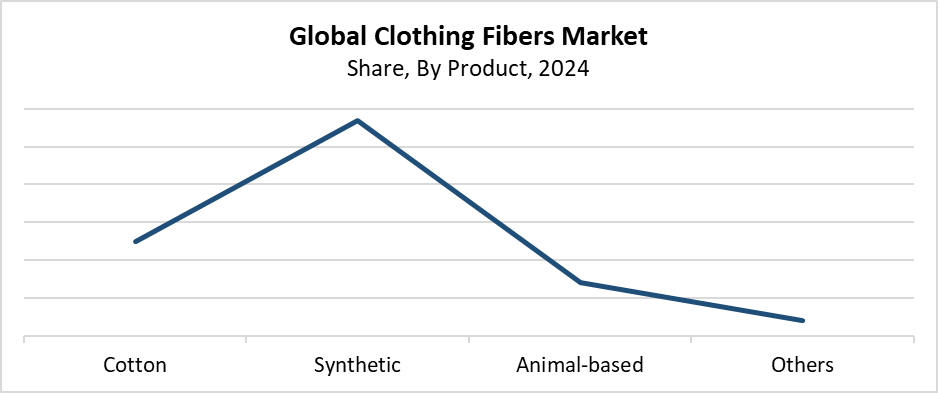Global Clothing Fibers Market
Global Clothing Fibers Market Size, Share, and COVID-19 Impact Analysis, By Product (Cotton, Synthetic, Animal-based, Others), By End Use (Women?s Wear, Men?s Wear, Kid's Wear), and By Region (North America, Europe, Asia-Pacific, Latin America, Middle East, and Africa), Analysis and Forecast 2025 - 2035
Report Overview
Table of Contents
Clothing Fibers Market Summary
The Global Clothing Fibers Market Size Was Estimated at USD 203.2 Billion in 2024 and is Projected to Reach USD 347.8 Billion by 2035, Growing at a CAGR of 5.01% from 2025 to 2035. The market for clothing fibers is expanding because of the growing demand for eco-friendly and sustainable materials, the fashion industry's rising trends, the world's population growth, fiber technology advancements, and consumer preferences for clothing fibers that are comfortable, long-lasting, and adaptable for a range of uses.

Key Regional and Segment-Wise Insights
- In 2024, the Asia Pacific held the largest revenue share of over 43.5% and dominated the market globally.
- In 2024, the synthetic segment had the highest market share by product, accounting for 57.3%.
- In 2024, the women's wear segment had the biggest market share by end use, accounting for 34.3%.
Global Market Forecast and Revenue Outlook
- 2024 Market Size: USD 203.2 Billion
- 2035 Projected Market Size: USD 347.8 Billion
- CAGR (2025-2035): 5.01%
- Asia Pacific: Largest market in 2024
The clothing fibers market represents the worldwide sector that creates and delivers fibers for textile production and garment manufacturing. The fibers used in textile production include cotton along with wool, polyester, nylon, and environmentally friendly alternatives such as bamboo and recycled fibers. The market experiences growth because consumers want fashionable clothing that lasts and provides warmth. The textile and clothing industries expand because of worldwide population expansion, together with rising consumer income levels, especially across emerging markets. The fashion industry experiences accelerated growth because consumers want clothing made with organic fibers and recycled fibers. Market growth occurs at a dynamic pace because of fast fashion trends, together with evolving customer tastes.
The clothing fiber market experiences significant changes from technological advancements, which enable smart, sustainable, and high-performance fiber creation. The functionality and attractiveness of fibers continue to advance because of technological breakthroughs, including moisture-wicking textiles, together with bio-based fibers and antimicrobial treatments. Sustainability receives support from worldwide governments through laws that promote eco-friendly fiber production, along with programs for trash reduction and recycling. Research on green textile technology receives accelerated market transformation through financial support and incentives. The future development of sustainable apparel fibers will emerge through the combined effects of innovative technologies and regulatory frameworks.
Product Insights

The synthetic segment dominated the clothing fibers market with the largest revenue share of 57.3% during 2024. The textile and clothing industries use synthetic fibers, including polyester, nylon, and acrylic, because they offer low prices and strong durability and flexible uses, thus driving their market dominance. The textile industry prefers synthetic fibers for fast fashion and sportswear because these materials stay wrinkle-free, resist moisture, and are easy to maintain. Modern production technology has enhanced both the quality and sustainability of synthetic fibers through the development of recycled polyester production. Textile production hubs expanding globally, along with rising market demand from developing regions, drive further growth for this segment. The garment fiber market continues to rely primarily on synthetic fibers, which undergo constant development to meet both consumer requirements and environmental standards.
The cotton segment within the clothing fibers market is anticipated to experience a significant CAGR during the forecast period. The natural fiber cotton remains popular because it provides comfort and breathability while being biodegradable, thus making it a top choice for environmentally conscious consumers. The rising understanding of the health and environmental advantages of organic cotton drives market demand for responsibly sourced cotton. The development of advanced cotton farming and processing methods leads to higher productivity levels and better fiber quality. The increased preference for natural clothing materials in warmer regions supports cotton's market growth. The fashion industry will drive substantial expansion for cotton because it needs to find an equilibrium between customer comfort and environmental sustainability.
End Use Insights
The women's wear segment leads the clothing fibers market with 34.3% revenue share in 2024. Women's worldwide preference for diverse fashionable clothing options drives this dominant market share in the clothing fibers sector. The expanding urban population, along with rising disposable income and growing fashion awareness, drives the growth of the women's clothing market. The market employs multiple fiber types, including natural and synthetic materials, to meet consumer demands for comfort and style and sustainability. The fast fashion sector's focus on women's clothing drives both rapid market development and quick product replacement cycles. The leadership of this market segment receives additional support through growing online retail platforms and promotional strategies that focus on female buyers.
The kids' wear segment of the clothing fibers market will exhibit the fastest CAGR during the upcoming forecast period. The market growth stems primarily from increasing birth numbers across developing nations and rising parental investment in quality, safe, and comfortable children's clothing. The market experiences rising demand because of the increasing awareness regarding natural fibers such as cotton and bamboo, which are hypoallergenic. The expanding e-commerce sector, together with social media growth, has driven the rapid increase of fashionable children's clothing available to consumers. Brands targeting health-conscious parents promote organic and sustainable fibers, which leads to segment growth. The increasing attention toward both comfort and style for children pushes the kids' clothing market forward.
Regional Insights
Asia Pacific leads the global clothing fibers market, accounting for the largest revenue share of 43.5% throughout 2024. The dominant position of the Asia Pacific in textile and garment manufacturing arises from its extensive manufacturing facilities that include Bangladesh, Vietnam, India, and China. Asia Pacific leads the market because it has large amounts of raw materials, low production costs, and an expert workforce. The rise of local consumption because of greater spending power, alongside better fashion knowledge, drives increased fiber demand. The area benefits from growing retail sectors as well as increasing urbanization. The region's market position becomes stronger through its strong export relations with foreign markets. As a key participant in the worldwide clothing fibers industry, the Asia Pacific invests in sustainable materials and advanced fiber technologies to shape future market expansion.
North America Clothing Fibers Market Trends
The North American market for clothing fibers is growing significantly through increasing customer interest in innovative, sustainable textile products. The rising environmental consciousness of customers and manufacturers drives them to select organic cotton, bamboo, and recycled polyester fibers as their preferred eco-friendly textile options. The region hosts numerous major clothing brands together with textile industries, which drives the continuous development of smart and performance fabric technologies. The athleisure and activewear categories have driven increased market demand for specialty fibers that offer both comfort and durability. The growing market receives positive boosts from both the emergence of e-commerce platforms and evolving fashion patterns. The North American apparel fibers market experiences enhanced growth because governments implement supportive policies that promote sustainable manufacturing practices.
Europe Clothing Fibers Market Trends
The European market for clothing fibers is expected to grow at a significant CAGR because of increasing consumer preference for sustainable and environmentally friendly fabrics. The region supports organic, recyclable, and biodegradable fibers together with mandatory ethical production standards and environmental rules. The market leaders are Germany, Italy, France, and the UK because they maintain established textile industries and focus on advancing fiber technology. Market growth receives additional support because technical textiles and athletics require high-performance fibers. Consumer behavior changes due to activities focused on the circular economy and sustainable fashion practices. Fashion designers, along with well-known labels that focus on sustainable sourcing, play a role in expanding the market. Through government support and research investments, Europe plays a vital role in worldwide apparel production.
Key Clothing Fibers Companies:
The following are the leading companies in the clothing fibers market. These companies collectively hold the largest market share and dictate industry trends.
- Eastman Chemical Company
- Hyosung TNC Corporation
- The Bombay Dyeing and Manufacturing Co. Ltd.
- Teijin Ltd.
- Indorama Ventures Public Company Limited
- Asahi Kasei Corporation
- Invista
- Toray Industries, Inc.
- Reliance Industries Limited
- Lenzing AG
- Others
Recent Developments
- In May 2025, Teijin Frontier unveiled a high-performance recycled polyester fabric that uses patented spinning and finishing techniques to replicate the texture and appearance of natural fibers. Made from 100% recycled polyester, the fabric has cooling touch, UV protection, anti-stick, and quick-dry qualities. It will go on sale in the spring or summer of 2026.
- In February 2025, Hyosung, Loop Industries, and Pleatsmama collaborated to develop limitless Loop textile-to-textile recycling technology, which helped to pioneer circular fashion. This partnership demonstrates how cutting-edge recycling technologies and circular fashion may promote sustainability across industries.
Market Segment
This study forecasts revenue at global, regional, and country levels from 2020 to 2035. Decision Advisors has segmented the clothing fibers market based on the below-mentioned segments:
Global Clothing Fibers Market, By Product
- Cotton
- Synthetic
- Animal-based
- Others
Global Clothing Fibers Market, By End Use
- Women’s Wear
- Men’s Wear
- Kid's Wear
Global Clothing Fibers Market, By Regional Analysis
- North America
- US
- Canada
- Mexico
- Europe
- Germany
- UK
- France
- Italy
- Spain
- Russia
- Rest of Europe
- Asia Pacific
- China
- Japan
- India
- South Korea
- Australia
- Rest of Asia Pacific
- South America
- Brazil
- Argentina
- Rest of South America
- Middle East & Africa
- UAE
- Saudi Arabia
- Qatar
- South Africa
- Rest of the Middle East & Africa
Check Licence
Choose the plan that fits you best: Single User, Multi-User, or Enterprise solutions tailored for your needs.
We Have You Covered
- 24/7 Analyst Support
- Clients Across the Globe
- Tailored Insights
- Technology Tracking
- Competitive Intelligence
- Custom Research
- Syndicated Market Studies
- Market Overview
- Market Segmentation
- Growth Drivers
- Market Opportunities
- Regulatory Insights
- Innovation & Sustainability
Report Details
| Pages | 234 |
| Delivery | PDF & Excel via Email |
| Language | English |
| Release | Oct 2025 |
| Access | Download from this page |
